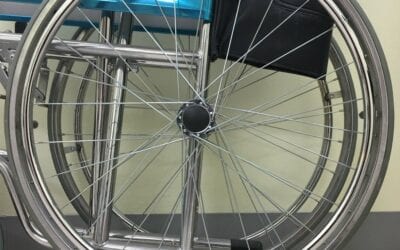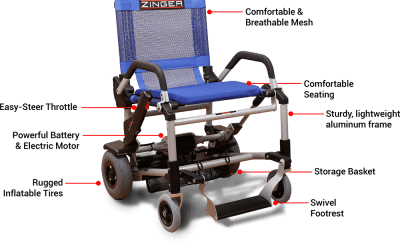Explore the world with our NCOA guide designed to make travel accessible, enjoyable, and worry-free for those using wheelchairs, walkers, and canes.

Written by: Lauren Sherman, MS
Medical Reviewer: Christopher Norman, MSN, APRN, APHN-BC, GNP-BC
Reviewed by: Susan Stiles,
Key Takeaways
- Accessible travel is vital for social inclusion, medical needs, and overall well-being, especially for older adults.
- More than 6.8 million Americans living outside of institutions use assistive devices to help them with movement. Around 1.7 million of those use a wheelchair or scooter, and the remaining 5.1 million use canes, crutches, and walkers.
- The Air Carrier Access Act and the Americans with Disabilities Act (ADA) regulations mandate accommodations in air and cruise travel.
- For road trips, safely stow mobility devices in the car and consider renting an accessible vehicle.
- Major train and bus lines offer accessible seating and facilities, but booking in advance is advised.
- Proper planning, including emergency preparedness and consulting with service providers, helps ensure a smooth travel experience for those with mobility devices.
Travel isn’t just a luxury; it’s a vital aspect of well-being, especially for older adults. Travel provides cognitive, social, and physical health benefits to older adults — a group that is more prone to developing difficulties in these areas. But for anyone who relies on mobility aids like wheelchairs, walkers, and canes, the idea of travel can seem daunting.
The good news is that accessible travel is not only possible but also increasingly more common and doable. Numerous blogs and services are dedicated to making travel accessible for everyone. Whether you’re traveling for leisure, family visits, or medical appointments, this guide aims to empower you with actionable information for a smooth and enriching journey that meets your mobility needs.
Planning tips for mobility-friendly travel
Proper planning is the cornerstone of any successful trip, and it’s even more crucial when you’re traveling with mobility aids. About 30 percent of Americans over the age of 65 living outside of institutions use assistive devices for mobility purposes, both inside and outside the home. Many use a wheelchair or scooter, while the greatest number use canes, crutches, and walkers. Traveling with mobility aids is possible, and can be done successfully by following a few planning tips:
- Research your destination: Before you book anything, research the accessibility features of your chosen destination. Look for hotels and rental properties with ADA-compliant rooms, and check if tourist attractions offer wheelchair ramps or other accommodations. Websites like WheelchairTravel.org provide valuable insight into the accessibility of locations.
- Consult your health care provider: Before embarking on your trip, consult your health care provider for a pre-travel check-up. Discuss your travel plans, and make sure you have enough medication and supplies for the duration of your trip.
- Communicate with transportation providers: When booking flights, notify the airline about your mobility device in advance. Most airlines offer assistance for boarding and deplaning, and narrow aisle wheelchairs are provided by the airlines to get you to your seat. If you’re traveling by train or bus, check their policies on mobility aids, since they differ.
- Communicate with your accommodation provider: Call hotels or rental properties directly to confirm the availability of accessible rooms. Inquire about ramps, elevator access, door widths, roll-in showers, and other features that can make your stay more comfortable. Plan accessible ground transportation ahead of time from your accommodation to your planned activities. A hotel will often be able to book this for you.
- Get insurance: Invest in a comprehensive travel insurance policy that covers medical emergencies and the potential loss or damage to your mobility device.
- Mobility device maintenance: Check the condition of your mobility device and consider a tune-up before the trip.
- Set aside some break/rest days: You don’t want to tire or stress yourself out by overscheduling every minute of your trip, so be sure to schedule moments to recharge.
Traveling checklist
Packing these items will help ensure a smooth trip:
- Mobility aid: Choose a device that is compact, foldable, and will travel easily. The scooter or wheelchair you use at home may be too bulky. Consider renting a more portable chair or scooter. If you are bringing a new device, be sure to practice with it until you are comfortable. Don’t wait until the trip to learn how to use it.
- Chargers and batteries: Bring extra batteries or chargers for electric wheelchairs and scooters.
- Medical supplies: Ensure you have enough medication and other medical supplies.
- Documentation: Keep copies of prescriptions and any other medical documentation.
- Emergency contacts: Draft a list of local health care providers and emergency services at your travel destination.
- Accessibility apps and guides: Download apps and guides that can help you find accessible routes and services. Apps like iAccess Life will help you navigate accessible routes and locations. Google Maps also has an “Accessible Places” feature, which labels accessible entrances, seating, restrooms, and parking. Additionally, Mobility International USA offers PDF guidebooks for accessible destinations around the world.
 Air travel with a mobility device
Air travel with a mobility device
Navigating the skies with a mobility device requires a bit more preparation, but it’s entirely achievable with the right knowledge and planning.
The Air Carrier Access Act
The Air Carrier Access Act (ACAA) is a U.S. federal law, first enacted in 1986, which prohibits discrimination against passengers with disabilities in air travel. Under the ACAA, airlines must accommodate travelers with disabilities, including those who use mobility devices. This means airlines are required to provide assistance for boarding, deplaning, and making connections, as well as stowing your mobility device. It’s important to familiarize yourself with the ACAA to understand your rights and what accommodations you can expect.
TSA Cares
The Transportation Security Administration (TSA) has a program called TSA Cares, which is a helpline that provides additional assistance during the security screening process for travelers with disabilities, medical conditions, and other circumstances. TSA Cares is staffed to provide travelers information on what to expect during the screening process Monday through Friday, from 8 a.m.–11 p.m. ET and weekends and holidays, from 9 a.m.–8 p.m. ET.
A traveler may request the services of a TSA Passenger Support Specialist (PSS), who can provide assistance through security screening. A PSS is a TSA officer who has received specialized training, including how to effectively assist and communicate with people with disabilities or medical conditions, and travelers who need additional screening assistance. You may call the number above or fill out an online form to request a PSS.
Planning air travel with a walker or cane
Air travel with a walker or cane is generally straightforward. Here’s what you need to know:
- Stowing the device: Walkers and canes are typically folded and stowed in the overhead compartment or a designated area in the cabin.
- Mobility assistance: Airlines offer escort services to help you move through the airport and onto the plane. You may also request an aisle wheelchair for easier boarding.
- Call ahead: While not mandatory, it’s advisable to notify the airline in advance that you’ll be traveling with a mobility aid. This ensures the crew is prepared to assist you.
- Label your device: Be sure to put your name on your device so there is no confusion if it gets gate checked.
Planning air travel with a wheelchair
Wheelchair travel involves a bit more planning but is still manageable. Here’s what you should know:
- Advanced notice: Always give the airline advance notice that you’re traveling with a wheelchair. This allows them to make the necessary preparations for your journey.
- Types of assistance: Airports offer various types of wheelchair assistance, such as escorting you through security and helping you board the plane.
- Your own device: You can generally use your own wheelchair or scooter up to the boarding gate. From there, it will be stowed in the cargo hold, and you’ll be transferred to an aisle wheelchair for boarding.
- Airport-issued wheelchair: Some travelers opt for an airport-issued wheelchair. If you choose this option, your personal wheelchair will be stowed immediately upon check-in.
Shannon MacDonald, an occupational therapist in Denver, Colorado, has guidance for navigating airports with mobility devices. Her number one recommendation is to plan ahead and not leave anything until the last minute. She tells her clients to take advantage of TSA PreCheck® and Global Entry in order to reduce delays. She told us you can now complete the TSA PreCheck application at any Staples store in the country.
Laurel McFarland of Parker, Colorado, is 75 years old and uses a cane after her double knee replacement surgery. She recently traveled through Denver International Airport (DIA), an airport that is notorious for long wait times. Ms. McFarland wishes she had known about the Staples option mentioned above by MacDonald. She underestimated how long it would take to get through DIA’s security. Laurel began the TSA PreCheck application online and planned to complete it at the airport, but found herself at the wrong end of the concourse without enough time to get to the other side. She was unable to complete or use TSA PreCheck and had to stand in a long, standard security line. Laurel also wishes she had accepted the wheelchair offer at check-in. She told us, “Next time, I’m taking the wheelchair. Who cares what it looks like.”

- Use crossbody bags or fanny packs to free up your hands
- Put your medications in carry-on bags
- Use Apple AirTags or Tile tags in checked luggage for easy trackability and peace of mind
- Take advantage of preboarding
- Start with shorter trips if longer ones seem daunting
MacDonald’s final words of advice were, “Don’t be afraid to travel — it’s so worth it!”
READ ALSO:
Why knowing airline wheelchair policies can make flying easier
Airlines damage passenger wheelchairs — more than 200 a week

Charlie Leocha is the President of Travelers United. He has been working in Washington, DC, for the past 14 years with Congress, the Department of Transportation, and industry stakeholders on travel issues. He was the first consumer representative to the Advisory Committee for Aviation Consumer Protections appointed by the Secretary of Transportation from 2012 through 2018.




